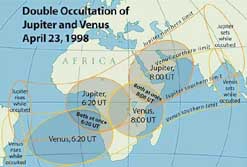 |
 19th April 1998 |
Front Page| |
People & Events
Watch the sky on April 23By Ranjit T EdwardMost astronomers like to assume that everyone takes pleasure in sky gazing. On the contrary, the sky to many is a puzzling tapestry of the stars and the indefinable nature of most constellations mars its appeal. For most of us the nightly maze makes as much sense as the filling of a typical form at the customs department. But when an absolutely dazzling event comes along, even the casual star gazers - those of who do not know that it takes 8 minutes for the light from the Sun to reach the earth - pay attention. Last year we had the extraordinary display of Comet Hale-Bopp. The year before Jupiter took a good walloping from Comet Shoemaker-Levy 9. What has the sky got for us this year? On April 23rd a super bright conjunction is a perfect example. Three of the main celebrities of the celestial theatre will put on a show. Jupiter, Venus and The Moon. They will form a tight little triangle that easily will qualify as the greatest show of the year.
Star gazers around the world can look forward to a close gathering of Venus, Jupiter and the waning crescent Moon on April 23rd. The best show will be in parts of Africa and Southern Asia. The Moon will occult both Jupiter and Venus, and in some places both will be in occultation at the same time. Venus meeting Jupiter is no surprise as they both orbit in nearly the same plan. The amazing thing is the Moon joins them. On all the other planets the moons circles the equator. Our Moon ignores the ordinary and travels like a planet in the zodiacal pattern. This is a strange and unique thing for a moon to do. This behaviour allows the Moon to glide next to the striking Venus -Jupiter pair. At first this show makes no sense. But look at it this way. A few friends standing together in the sunlight. They all show the same illumination. But, what happens if one's head was half illuminated from the right, the other from the left and one fully illuminated. Now, wouldn't this be like a bizarre scene from a science fiction movie. This is the kind of event that would have driven the ancient Mayas into absolute frenzy. The map outlines the situation. Each occultation begins in eastern most South America, where the moon rises on the predawn horizon. The occultation zones then pass across the Atlantic Ocean and Africa, finally ending in Southern Asia at moonset during daylight. This may cause a problem for us in Sri Lanka as the occultation happens in daylight. Here a telescope will be needed. And if you are still not able to observe it, there is relief. The Internet. Visit HYPERLINK http://www. staigerland.com www. staigerland.com, and with any luck, the double occultation will be netcast as it happens. The physical beauty of the event nicely illustrates why ancient cultures made such a fuss over this sort of tight, brilliant planetary configuration. The secret lies in the enormous disparity between the moon's and the planet's distance from us. Although the three of them seemed to be lumped together, the moon is less than 2 seconds from us in terms of the time it would take light (300,000 Km/Sec) to travel from the moon to the earth. Venus is 10 minutes away (on the same yardstick) and Jupiter about 60 minutes. Now, imagine this little picture. The Moon is between us and the Sun. Therefore it is lit up from the back. A typical crescent moon. Venus is on the far end at nearly a right angle to us and the Sun. Therefore it appears half bright and half dark. And Jupiter lies on the far side of its orbit away from the Sun. The giant is so far from the Sun and us that the disc is quite visible. The show will be quite spectacular in its own right. It is not always one gets the opportunity to see such an event. There are 13 double occultations of bright planets between the years 1600 and 2200. The most recent one was of Mars and Jupiter on February 8th, 1951. The next will include Mercury and Mars on February 13th 2056. Both these events, however, are much closer to the Sun than April's occultation, when Jupiter and Venus will be 45 degrees west of the Sun. In fact, this event has the greatest solar elongation of any since 1683.
Green light for snail projectBy Chamintha ThilakarathnaBelieve it or not, they have been around for a long time. Longer than one can imagine. Even before the time of the dinosaurs. If only they could speak, we would probably know what life before man was like. Of the 250 snail species listed in the world, 205 are given as endemic to Sri Lanka, which gives us a 82% endemism rate. In addition to high diversity and endemism, Sri Lanka possesses the most distinctly South Asian land snail fauna. The majority of the molluscs found here are those whose origins go back for over 19 million years, says Fred Naggs, Curator of Non-Marine Mollusc Zoology, of the Natural History Museum in London.
"At present, there is no national collection of fauna due to lack of expertise and interest in the field of taxonomy. We want to establish a national zoological collection and data bank, for which we have received permission to use the Jayawardenapura campus as the base. Mr.Naggs will advise us on how to do this and in training local scientists," said Dr.K.D.Arulpragasm, a member of the body. In the case of tree snails, the slimy creatures that crawl up the trees in our gardens, Naggs says they only exist in Sri Lanka. "Acavus (a type of snail) thrives in village gardens where it may occur in greater abundance than in natural forest. Contrary to references where they describe only the day time behaviour, remaining on tree trunks and showing little mobility, they are very active nocturnally. At night they descend from the trees and presumably making use of the smell, converge on rotting fruit in large numbers. The abundance of such food seems likely to account for the high density of Acavus in village gardens," he said. "The first requirement for the study of any group of organisms is to identify material. Serious investigations require access to the literature and specimen reference collections. There is an urgent need for these basic taxonomic tools to be accessible at a local level," said Naggs. He added that the first step in doing this is to find a place to house, process technical material and preserve it, etc. Even in order to identify one has to have access to material and this is where the British Natural History Museum comes in. "We will be providing the necessary material and the know how with our large collection. We will be sending experts to train scientists here as well." The NARESA Zoological Surveyors body hopes to launch the project shortly. |
||
 |
More Plus * In the original Garden of Eden
Front Page| News/Comment| Editorial/Opinion| Business| Sports | Mirror Magazine |
|
 |
Please send your comments and suggestions on this web site to |
|
 The
night sky contains many wonders. Most of them being static displays. In
contrast occultations are dynamic phenomena that provide an astonishing
performance of orbital motion. To occult means literally "hide".
A lunar occultation takes place when the moon's edge creeps up to a star
and suddenly snuffs it out. The star reappears on the opposite side about
an hour later.
The
night sky contains many wonders. Most of them being static displays. In
contrast occultations are dynamic phenomena that provide an astonishing
performance of orbital motion. To occult means literally "hide".
A lunar occultation takes place when the moon's edge creeps up to a star
and suddenly snuffs it out. The star reappears on the opposite side about
an hour later. "In
countries like India, colonization has destroyed the best molluscs, so
one cannot find the original species for they have undergone a lot of change.
But in Sri Lanka it is not so. The snails and shell animals remain the
same as the original species. This is one of the main reasons why they
should be listed and preserved here," said Naggs, who was here recently
on an invitation of the NARESA Zoological Surveyors body of Sri Lanka to
form a data bank and preservation centre.
"In
countries like India, colonization has destroyed the best molluscs, so
one cannot find the original species for they have undergone a lot of change.
But in Sri Lanka it is not so. The snails and shell animals remain the
same as the original species. This is one of the main reasons why they
should be listed and preserved here," said Naggs, who was here recently
on an invitation of the NARESA Zoological Surveyors body of Sri Lanka to
form a data bank and preservation centre.